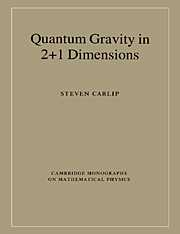Book contents
- Frontmatter
- Contents
- Preface
- 1 Why (2+1)-dimensional gravity?
- 2 Classical general relativity in 2+1 dimensions
- 3 A field guide to the (2+1)-dimensional spacetimes
- 4 Geometric structures and Chern–Simons theory
- 5 Canonical quantization in reduced phase space
- 6 The connection representation
- 7 Operator algebras and loops
- 8 The Wheeler–DeWitt equation
- 9 Lorentzian path integrals
- 10 Euclidean path integrals and quantum cosmology
- 11 Lattice methods
- 12 The (2+1)-dimensional black hole
- 13 Next steps
- Appendix A The topology of manifolds
- Appendix B Lorentzian metrics and causal structure
- Appendix C Differential geometry and fiber bundles
- References
- Index
11 - Lattice methods
Published online by Cambridge University Press: 15 December 2009
- Frontmatter
- Contents
- Preface
- 1 Why (2+1)-dimensional gravity?
- 2 Classical general relativity in 2+1 dimensions
- 3 A field guide to the (2+1)-dimensional spacetimes
- 4 Geometric structures and Chern–Simons theory
- 5 Canonical quantization in reduced phase space
- 6 The connection representation
- 7 Operator algebras and loops
- 8 The Wheeler–DeWitt equation
- 9 Lorentzian path integrals
- 10 Euclidean path integrals and quantum cosmology
- 11 Lattice methods
- 12 The (2+1)-dimensional black hole
- 13 Next steps
- Appendix A The topology of manifolds
- Appendix B Lorentzian metrics and causal structure
- Appendix C Differential geometry and fiber bundles
- References
- Index
Summary
In a number of quantum field theories – quantum chromodynamics, for example – a standard approach to conceptual and computational difficulties is to discretize the theory, replacing continuous spacetime with a finite lattice. The path integral for a lattice field theory can be evaluated numerically, and insights from lattice behavior can often teach us about the continuum limit. Gravity is no exception: one of the earliest pieces of work on lattice field theory was Regge's discretization of general relativity, and the study of lattice methods continues to be an important component of research in quantum gravity.
Like other methods, lattice approaches to general relativity become simpler in 2+1 dimensions. Classically, a (2+1)-dimensional simplicial description of the Einstein field equations is, in a sense, exact: tetrahedra may be filled in by patches of flat spacetime, and it is only at the boundaries, where patches meet, that nontrivial dynamics can occur. This means, among other things, that the constraints of general relativity are much easier to implement. Recall that the constraints generate diffeomorphisms, and can thus be thought of as moving points, including the vertices of a lattice. In 3+1 dimensions, this causes serious difficulties. In 2+1 dimensions, however, the geometry is insensitive to the location of the vertices, so such transformations are harmless. Equivalently, the diffeomorphisms can be traded for gauge transformations in the Chern–Simons formulation of (2+1)-dimensional gravity, and these act pointwise and preserve the lattice structure. Similarly, the loop representation of chapter 7 is naturally adapted to a discrete description: as long as a lattice is fine enough to capture the full spacetime topology, the holonomies along edges of the lattice provide a natural (over)complete set of loop operators.
- Type
- Chapter
- Information
- Quantum Gravity in 2+1 Dimensions , pp. 171 - 193Publisher: Cambridge University PressPrint publication year: 1998

